Alnwick (AN-ik, with a silent l and w) is a small market town in north Northumberland. The town's population was just over 8000 at the time of the 2001 census and Alnwick's district population was 31,029.
According to Country Life, October 2002, "Alnwick is the most picturesque market town in Northumberland, and the best place to live in Britain".
The town dates back to approximately AD 600, and over the centuries has thrived as an agricultural centre; as the location of Alnwick Castle and home of what were in mediaeval times the most powerful northern barons, the Earls of Northumberland; as a staging post on the Great North Road between Edinburgh and London, and latterly as a modern rural centre cum dormitory town. The fabric of the town centre has changed relatively little and still retains much of its original character; however there has been appreciable growth in size over the last ten years, with a number of housing estates covering what had been pasture, and new factory and trading estate developments along the roads to the south of the town.
At various points in the town are memorials of the constant wars between Percys and Scots in which so many Percys spent the greater part of their lives. A cross near Broomhouse Hill across the river from the castle marks the spot where Malcolm III of Scotland was killed in 1093, during the first Battle of Alnwick. At the side of the broad shady road called Rotten Row, leading from the West Lodge to Bailiffgate, a tablet of stone marks the spot where William the Lion of Scotland was captured in 1174, during the second Battle of Alnwick by a party of about four hundred mounted knights, led by Ranulf de Glanvill; and there are many others of similar interest.
In the winter of 1424, much of the town was burnt by a Scottish raiding party.
Notable people Born in Alnwick
- William of Alnwick, (c. 1275-1333), Franciscan Theologian and Bishop of Giovinazzo.
- William Henry Percy (1788–1855), naval commander and politician.
- George Biddell Airy, (1801–1892), Astronomer Royal from 1835 to 1881
- Bernard Bosanquet, (1848–1923), philosopher
- John Busby, (1765–1857), mining engineer
- Henry 'Hotspur' Percy, (1364?–1403), son of the 1st Earl of Northumberland
- T. J. Cobden Sanderson, (1840–1922), artist and bookbinder associated with the Arts and Crafts movement
- Prideaux John Selby, (1788–1867), ornithologist, botanist and artist
- Ralph Tate, (1840–1901), botanist and geologist
- Sid Waddell, (born August 10, 1940) commentator and television personality
Died in Alnwick
- Malcolm III of Scotland – (d.1093)
- Tip Tipping, (1958–1993), actor, died in a parachuting accident
Description courtesy of Wikipedia.
8th August 2010
.jpg)
The Hotspur Gateway or Bondgate Tower, Bondgate Within.
Built after 1434 (circa 1450) by the 2nd Earl of Northumberland. East gate in former town walls, polygonal on each side of arched thoroughfare on outside, straight front to west. Not crenellated. Rough ashlar. Three stages. Central segmental. Archway with vaulted passage on 4 wide ribs.
East face: remains of large corbels in centre, panel below with much faded lion rampant by a sculptor named Matthew, narrow lookouts. West face; slight set back above 2nd stage, a plain 2 light mullion window above the archway and a blocked cross window to left. There are portcullis slits to the outer arch. The old A1 road used to pass through here.
Scheduled Ancient Monument. Source: Historic England.
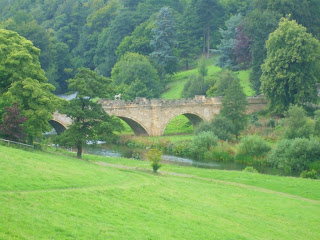.jpg)
.jpg)
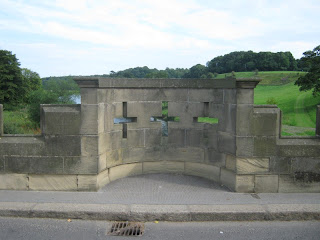.jpg)
.jpg)
The Lion Bridge.
1775 by John Adam. Ashlar. Three arches and a smaller land arch. Polygonal look outs on each side. Corbelled arcade to crenellated parapet. In the centre on the east side stands the Percy Lion in cast lead. Matching it on the west side was reputedly once a unicorn (symbolizing Scotland).
Curved approach parapets with close-set petrified stockade over a round section string and circular end piers. Look outs have blind arrow slits with hood moulds; merlons in crenellations. On the central die on the west side is roughly engraved "Foxy's Leap Au 12 1867" (recording the escape of a militia man). Spandrels of arches over river have circular panels containing blind shields. The panel on which the lion stands has on tile river side, 3 long shields linked by swags.
Scheduled Ancient Monument. Source: Historic England.

St Michaels Church.
St Michael’s Church is located on Bailiffgate in Alnwick, Northumberland. The current building dates from the 15th century, but includes some remnants of an earlier 12th century Norman chapel on the site. There may possibly also have been an earlier 8th century Saxon church here. The present church had major restorations in 1782, 1818 and 1863.
Grade 1 listed. Source: Co-Curate.

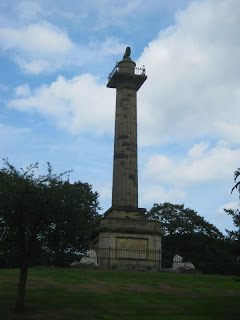.jpg)
Percy Tenantry Column.
When agricultural prices fell after the Napoleonic Wars, Hugh, the 2nd Duke of Northumberland, reduced the rents of his tenants by a quarter to alleviate their hardship. The column, in a prominent location in Alnwick, was paid for by the tenants in thanks for this.
The foundation stone was laid on 1st July 1816 and the column was built by the Duke's architect David Stephenson using tenant labour. It has been suggested that features of the Tenantry Column may have inspired the design of Nelson's Column in Trafalgar Square, London Inscription: "TO HUGH, DUKE OF NORTHUMBERLAND, K.G. IS ERECTED, DEDICATED, AND INSCRIBED, BY A GRATEFUL AND UNITED TENANTRY / ANNO DOMINI MDCCCXVI."
Grade 1 listed. Source: Co-Curate.
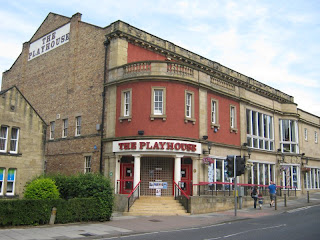.jpg)
Alnwick Playhouse.
The Alnwick Playhouse is an arts centre, theatre and cinema in the town of Alnwick in Northumberland, England. It is also the headquarters of the NTC Touring Theatre Company.
The building itself consists of many different parts. There is the main stage (with green room behind it) and an auditorium that sits over 200 people. Underneath the auditorium is a bar area with seating. On the ground floor, there is a foyer, a box office, a workshop, the NTC Touring Company office and a small 'black box theatre' style performance/rehearsal space with some limited seating.
he Playhouse was originally built in 1925 as a 700-seat cinema and occasional music hall. The Playhouse eventually closed in 1979. The NTC Touring Theatre Company bought the building and converted the ground floor. The upper floor was leased out to The Alnwick District Playhouse Trust who re-opened the newly refurbished Alnwick Playhouse in December, 1990. It has remained open since then.
Source: Wikipedia.
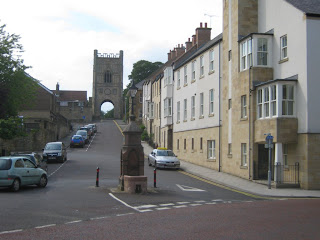.jpg)
Pottergate Tower.
Pottergate Tower in Alnwick was formerly part of the town's medieval defences. The tower was rebuilt in 1768 to a design by Mr Henry Bell. It used to have a crown spire, which was removed in 1812. The tower is Grade II* listed on the National Heritage List for England. The tower has been converted for use for tourist accommodation.
Source: Co-Curate.
.jpg)

Barter Books (Old Alnwick Train Station).
Alnwick Railway Station on Wagon Way Road in Alnwick was opened on the 5th September, 1887. It was built as part of the Alnwick to Cornhill branch line, by the North Eastern Railway, which opened on that same day.
It replaced an earlier station on the outskirts of Alnwick, which was opened in 1850 by Newcastle and Berwick Railway with a railway line to Alnmouth. Alnwick station was closed in 1968 and now 'Alnmouth for Alnwick' Station is the nearest railway station. The old goods shed from Alnwick Station was dismantled and relocated to Beamish as part of it's Rowley Station. The former Alnwick Station itself, is well preserved and now hosts Barter Books in Alnwick.
Grade 2 Listed. Source: Co-Curate.
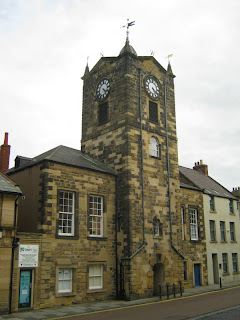.jpg)
Town Hall, Market Place.
Clock tower by Mr Bell 1767 and corner spires of tower by Mr George Hastings 1771. Two storeys and 5 bays. Ashlar with rusticated quoins. Band course to high parapet. Steps to boxed porch on 1st floor to right. Hipped slate roof with clock tower behind ridge.
Larger glazing bar sash windows on 1st floor with moulded architraves. Small glazing bar sash windows on ground floor. C20 shop front with recessed doorway to left. Boldly rusticated central archway to throughpassage.
Memorial tablet over central 1st floor window reads: "This Town House of the Burgesses of Alnwick rebuilt in the year of Our Lord 1731 by Edward Grey, Richard Grieve, William Forster, Robert Claxton: Chamberlains." To the left is a lead rainwater pipe head with fluted cap, the box has a St Michael and Dragon on 3 faces and also the names Stother, Forster, Gibson, Hardy and the date 1790 (possibly for roof repairs), The Fenkle Street front breaks forward slightly to the tower bay of 3 stages; a band course above each stage and an open pediment and parapet above to each side; it is capped by a small pointed cupola with a weathervane and corner pinnacles.
A clock on each face with louvred openings below (original clock removed to Pottergate Tower qv 1772). A round headed window at the top of the 3rd stage and a smaller one at the base of the 2nd stage with raised surrounds, Boldly rusticated throughpassage archway at the base. Two glazing bar sash windows on each side of the tower with moulded architraves; doorway to right with raised surround; similar doorway to left now a window.
Source: Historic England.
.jpg)
War Memorial.
The war memorial in Alnwick is located at the junction of Denwick Lane and Bondgate Without, near the Percy Tenantry Column. The memorial was unveiled by the Duke of Northumberland and dedicated by the Bishop of Newcastle on the 11th of Novermber 1922. The memorial has a central stone column supporting an ornamental lamp holder. There are 3 bronze figures around the column; a soldier, sailor, airman (by R Hedley 1921), mourning with reversed rifles. The monument has plaques with the names of those from Alnwick killed in the First World War and from the Second World War.
Grade 2 listed. Source: Co-Curate.
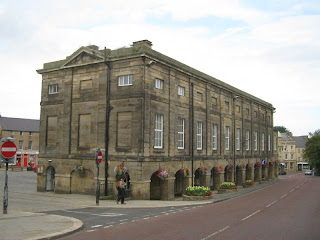.jpg)
Northumberland Hall (Assembly Rooms), Market Place.
1826 with octagonal extension 1830. Built by Duke of Northumberland. Three storeys, 10 windows; ashlar built.
Arcade of depressed arches continued round octagonal, East end with band above; giant order pilasters to moulded cornice; band below 2nd floor; parapet to hipped slate roof. One ridge chimney to west, another on east end wall. Second-floor window mostly blind (1st floor attic). First floor windows have glazing bar and casement arrangement for upper windows.
Within arcade a ceiling of long slabs, 1st bay from west blocked and with an upright cast iron pump outside (disused). Old arrangement of market booths with a smallish window between doors still largely survives. East end only 2 storeys to octagonal extension; gable end of main part, articulated with a pediment flanked by 2 giant order pilasters and having antefixae. At west end, blind central ground floor arch has tablet commemorating the gift of the Hall by the Duke to the town 1919.
Grade 2 listed. Source: Historic England.
Alnwick Market Cross.
In north-east corner of Market Place. Octagonal plinth and steps (8) and the octagonal shaft from an earlier cross on this site. Head of cross formed by lozenge shaped blind tracery panels. The necking has crescents and manacles at its cardinal points (Percy).
Grade 2 listed. Source: Historic England.
.jpg)
Market Square.
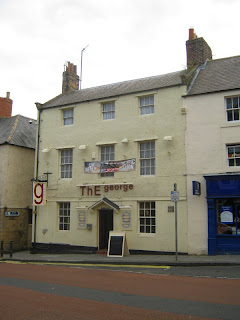.jpg)
The George Inn, 63 Bondgate Within.
.jpg)
Narrowgate, No 11.
1855 playful Gothick, by William Smith. Built as a Savings Bank on an acutely pointed corner site. Three storeys and attic, 2 windows on each side and one on gable end. Ashlar.
Corner flanked by octagonal piers terminating as pinnacles with clustered capitals. First and 2nd floor cill strings. Glazing bar sash windows faith cusped glazing in margins; depressed and round ogee window heads. Corner windows heavily framed and hooded with crocketted labels; attic window gabled with pinnacles. Tracery panels below 1st floor windows. Second floor corner window has "Savings Bank" in raised letters below it. Side elevations: depressed arch heads to windows, blind cusped tracery parapet. Moulded reveals to windows with Tudor bases.
Grade 2 listed. Source: Historic England.
.jpg)
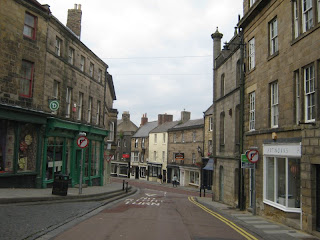.jpg)
.jpg)
Narrowgate.
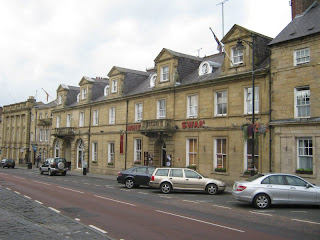.jpg)
White Swan, Bondgate Within.
.jpg)

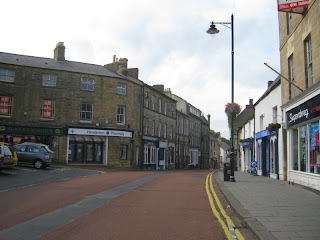.jpg)
.jpg)
Lloyd's Bank, 24, Bondgate Within.
The most prominent in a row of 5 banks. Circa 1910 by George Reavell a local architect. Banker's Georgian style. Three storeys, 6 windows, 4 centre bays framed by giant order of swagged Ionic columns, flanked on outside by rusticated piers.
Side bays plain. Ashlar; cill course to piano nobile whose windows have triangular and segmental pediments. Balustrated parapet. Casement windows with moulded architraves, 2nd floor windows with aprons. On the ground floor the 2 centre bays have tripartite windows, 2 outer bays, have recessed round hooded doorways with rusticated voussiors and enormous console keys.
Grade 2 listed. Source: Historic England.
.jpg)
The Northumberland Gazette, No 32 Bondgate Without.
.jpg)
Bailiffgate.
More Information:
- Wikipedia - Alnwick
- Keys To The Past - Alnwick
- Historic England - Former Railway Station, Alnwick - Barter Books
- Historic England - Alnwick
- Historic England - St Michaels Church
- Historic England - Pottergate Tower
- Northumberland Communities - Alnwick
- Co-Curate - Alnwick
- Co-Curate - Historic Buildings and Monuments in Alnwick
- The Alnwick Horror
- Alnwick Wildlife Group
See my other photos around Alnwick:

No comments:
Post a Comment